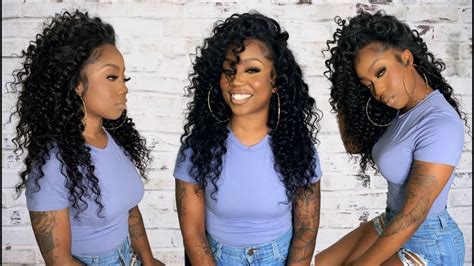Table of Contents
- Introduction
- Types of Sew In Weaves
- Benefits of Sew In Weaves
- Drawbacks of Sew In Weaves
- How to Prepare for a Sew In Weave
- Step-by-Step Sew In Weave Installation
- Maintaining Your Sew In Weave
- Troubleshooting Sew In Weave Problems
- Tips and Tricks for a Flawless Install
- Common Mistakes to Avoid
Introduction
Sew in weave hair extensions are a popular method of achieving longer, fuller hair. They involve sewing individual hair wefts into your natural hair, creating a secure and long-lasting bond. With proper care and maintenance, sew in weaves can last up to three months.

Types of Sew In Weaves
1. Machine Sew In Weaves
Machine sew in weaves are done using a special sewing machine designed for hair extensions. This method is faster and more efficient than hand sewing, but it can also be more damaging to your natural hair.
2. Hand Sew In Weaves
Hand sew in weaves are done by hand, using a needle and thread. This method is more time-consuming, but it is also more gentle on your natural hair.
3. Micro Link Sew In Weaves
Micro link sew in weaves use tiny metal rings to attach the hair wefts to your natural hair. This method is less damaging than traditional sewing methods, but it can be more time-consuming.
Benefits of Sew In Weaves
- Length: Sew in weaves can add significant length to your hair, up to 24 inches or more.
- Volume: Sew in weaves can add volume to thin or fine hair, creating a fuller, more voluminous look.
- Versatility: Sew in weaves can be styled in a variety of ways, including straight, curly, or wavy.
- Long-lasting: Sew in weaves can last up to three months with proper care and maintenance.
- Protection: Sew in weaves can protect your natural hair from heat damage and breakage.
Drawbacks of Sew In Weaves
- Cost: Sew in weaves can be expensive, costing anywhere from $200 to $1,000 or more.
- Installation time: Sew in weaves take several hours to install, depending on the method used.
- Maintenance: Sew in weaves require regular maintenance, including combing and washing.
- Damage: Sew in weaves can damage your natural hair if they are not installed or maintained properly.
How to Prepare for a Sew In Weave
Before you get a sew in weave, it is important to prepare your natural hair. This includes:
- Washing your hair with a clarifying shampoo
- Conditioning your hair with a moisturizing conditioner
- Detangling your hair with a wide-toothed comb
- Drying your hair completely
Step-by-Step Sew In Weave Installation
1. Section your hair. Divide your hair into small, even sections. The number of sections will depend on the length and thickness of your hair.
2. Braid your hair. Braid each section of hair tightly. This will create a base for the hair wefts.
3. Attach the hair wefts. Sew the hair wefts to the braids using a sewing machine or needle and thread. Start at the bottom of the section and work your way up.
4. Trim the hair. Once all the hair wefts are sewn in, trim the hair to the desired length.
5. Style your hair. Style your hair as desired. You can use heat tools, but be sure to use a heat protectant spray to prevent heat damage.
Maintaining Your Sew In Weave
To keep your sew in weave looking its best, it is important to maintain it properly. This includes:
- Regular combing: Comb your hair with a wide-toothed comb to prevent tangles and matting.
- Regular washing: Wash your hair with a sulfate-free shampoo. Avoid over-washing, as this can strip your hair of its natural oils.
- Conditioning: Condition your hair with a moisturizing conditioner. Leave the conditioner in for at least 30 minutes before rinsing.
- Drying: Dry your hair completely before going to bed. Air drying is best to prevent heat damage.
- Regular tightening: You will need to have your sew in weave tightened every 2 to 4 weeks. This will prevent the wefts from slipping and falling out.
Troubleshooting Sew In Weave Problems
If you are experiencing problems with your sew in weave, it is important to try to troubleshoot the issue. Some of the most common problems include:
- Tension: The wefts may be too tight or too loose. If the wefts are too tight, it can cause pain and damage to your natural hair. If the wefts are too loose, they may slip and fall out.
- Tangles and matting: Your hair may become tangled and matted if it is not combed regularly. Tangled hair can be difficult to detangle and can lead to breakage.
- Shedding: Your hair may shed if the wefts are not sewn in securely. Shedding can be unsightly and can also lead to bald spots.
Tips and Tricks for a Flawless Install
Here are a few tips and tricks for a flawless sew in weave install:
- Choose a reputable hair stylist who has experience with sew in weaves.
- Use high-quality hair wefts that are a good match for your hair type and texture.
- Take care of your natural hair before and after the install.
- Follow the maintenance instructions carefully to keep your sew in weave looking its best.
Common Mistakes to Avoid
Here are a few common mistakes to avoid when getting a sew in weave:
- Not preparing your hair properly. This can lead to the wefts slipping and falling out.
- Using low-quality hair wefts. This can lead to tangling, matting, and shedding.
- Over-washing your hair. This can strip your hair of its natural oils and lead to breakage.
- Not tightening your weave regularly. This can cause the wefts to slip and fall out.
- Using heat tools on your weave without using a heat protectant spray. This can lead to heat damage and breakage.
